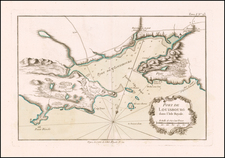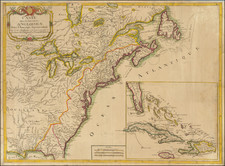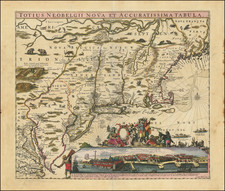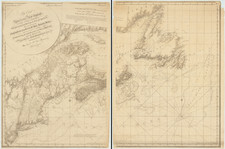Remarkable separately issued variant of this important colonial map of the Hudson River and its tributaries, including the Mohawk, and also with New Jersey and the upper course of the St. Lawrence River. Settlement in New York is almost entirely confined to the banks of the Hudson and Mohawk rivers. The unexplored Adirondack County is left entirely blank, with a lengthy notation that begins, Coughsaghrage or the Beaver Hunting Country of the Confederated Indians. Pennsylvania extend north into western New York state almost as far as the Mohawk, and Vermont is shown attached to New York, with each existing township identified. Interesting notations on the country are scattered across the face of the map.
The map is beautifully illustrated, with a pastoral title cartouche suggestive of the Hudson Palisades in the lower right hand corner. There are three large insets: 1) A Chart of the Mouth of Hudsons River from Sandy Hook to New York. This is in effect a chart of New York Harbor, with depth soundings, shoals, and other marine information laid down; 2) A Plan of Amboy. The city of Perth Amboy, the old capital of New Jersey, and the most important port in that province; 3) A Plan of the City of New York. Twenty five important sites are identified by key.
The map was prepared by Major Samuel Holland, Surveyor General for the Northern District of North America and issued as early as 1768.. As a result of The French and Indian War (1755-1763), Great Britain had significantly expanded its interests in America, for which there were few adequate maps. Two new offices of surveyor general for the American colonies were established in 1763-64. The colonies were divided at the Potomac River into a northern and southern district and the respective surveyors appointed were Samuel Holland and Gerard De Brahm. Holland conceived of a general survey of North America east of the Mississippi to be based upon geodetic principles, on a scale of one inch to one mile. Work was interrupted in 1775 by the outbreak of the American Revolution. There are six known states of the map, including five published in London states. State three adds the inset plans. State four had numerous alterations, particularly in upstate New York, where numerous new land grants were added. These changes were based on original materials provided by Thomas Pownall, who had previously served as governor of both New York and Massachusetts, and was extremely interested in colonial topography.
This very rare German edition is a faithful re-engraving of the fifth and most complete of the London states. The use of English is preserved for the title, all place names, notations, and legends. The Library of Congress has a copy of the German edition with the notation Presented to the Department of State by Benj. F. French January 1st, 1834. The present example is partially mounted on two original sheets of paper for rolling and has never been folded. Given the source and condition of the map, it may reasonably be surmised that it was brought to the America from Germany by a German Officer during the American Revolution. Two small candle wax spots minor creases from having been rolled for the past 200+ years, else a nice example.











![[ Large Cape Cod Inset ] The River & Gulf of St. Lawrence, Newfoundland, Nova Scotia, and The Banks Adjacent, From The English Admiralty & French Marine Surveys. . . . 1844. Additions To 1857.](https://storage.googleapis.com/raremaps/img/small/85637.jpg)


![[Untitled Map of The Atlantic Ocean, Europe, Africa, the Middle East, and Eastern Canada]](https://storage.googleapis.com/raremaps/img/small/89582.jpg)
